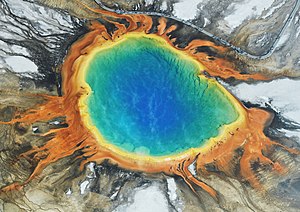Thermophile

A thermophile is an organism – a type of extremophile – that thrives at relatively high temperatures. That means between about 40 and 120 °C (104 and 248 °F).[1][2] Many thermophiles are archaea. Thermophilic eubacteria may have been among the earliest bacteria.[3]
Thermophiles are found in various geothermally heated parts of the Earth's surface. Examples are hot springs like those in Yellowstone National Park and deep sea hydrothermal vents. Also decaying plant matter, such as peat bogs and compost, makes higher temperatures.
References[change | change source]
- ↑ Madigan M.T. Martino J.M. (2006). Brock biology of microorganisms (11th ed.). Pearson. p. 136. ISBN 0-13-196893-9.
- ↑ Takai T.; et al. (2008). "Cell proliferation at 122°C and isotopically heavy CH4 production by a hyperthermophilic methanogen under high-pressure cultivation". PNAS. 105 (31): 10949–51. Bibcode:2008PNAS..10510949T. doi:10.1073/pnas.0712334105. PMC 2490668. PMID 18664583.
- ↑ Horiike T, Miyata D, Hamada K; et al. (January 2009). "Phylogenetic construction of 17 bacterial phyla by new method and carefully selected orthologs". Gene. 429 (1–2): 59–64. doi:10.1016/j.gene.2008.10.006. PMC 2648810. PMID 19000750.
{{cite journal}}: CS1 maint: multiple names: authors list (link)
